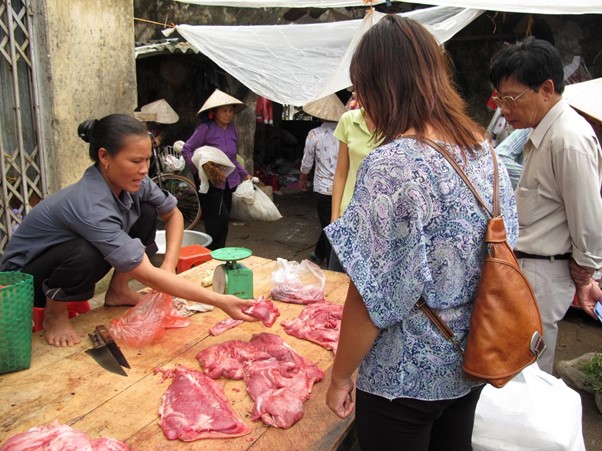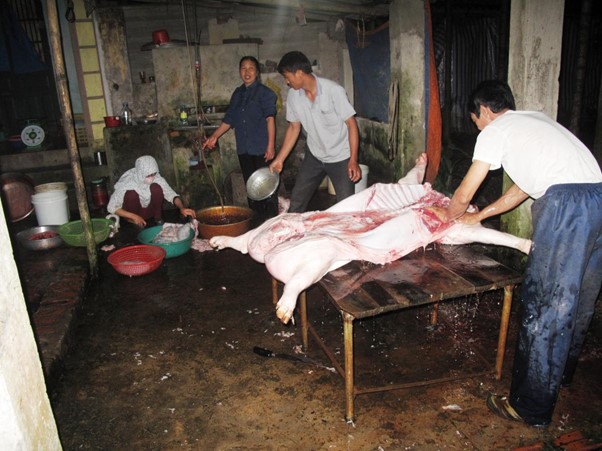TRUNG TÂM NGHIÊN CỨU Y TẾ CÔNG CỘNG VÀ HỆ SINH THÁI
CENTER FOR PUBLIC HEALTH AND ECOSYSTEM RESEARCH
CENPHER

Our main food safety issues relate to microbial contamination and toxins, pesticide use, antibiotic resistance, and growth promoters. The risk-based approach to food safety management is still not-well known and is rarely applied in the developing world. We generated evidence of how risk assessments can be used for specific cases of food safety management and how they are important to assist policy makers in the use of this approach for food safety management.
Risk assessments for food safety: pork value chain
In a 2013 study of Salmonella contamination in four pig slaughterhouses in Hung Yen, samples were taken from pig carcasses, workers’ hands, cutting boards, and belly skin material. The prevalence of Salmonella on pig carcasses was found to be 35% and the most common contamination point was workers’ hands. This very high Salmonella prevalence likely presents real risks to human health. The study suggests that interventions emphasising good hygienic practices, especially hand washing, would reduce contamination risks.
In Hanoi we examined how people’s household cooking and eating habits exposed them to Salmonella. Evidence of Salmonella contamination was found in 25% of the pork samples at markets where people shopped, and people’s food preparation methods risked spreading the bacteria to other foods in their households. Given the difficulty of changing the food-handling practices of millions of people, the best interventions are likely those that control Salmonella in the value chain before it reaches consumers.

Reducing human disease risks and improving food safety in smallholder pig value chains in Vietnam (the PigRisk program):The five-year (2012-2017) PigRisk project funded by the Australian Centre for International Agricultural Research (ACIAR) through the International Livestock Research Institute (ILRI), and implemented by CENPHER and its partners, aims at assessing the impact of pork-borne diseases on human health and the livestock sector to identify critical points/opportunities for risk management, and develop and test incentive-based innovations to improve the management of human and animal health risks in smallholder pig value chains.
Some of the early risk and economic assessment achievements of PigRISK were a series of literature reviews on foodborne hazards, pig zoonoses and pig diseases that showed biological hazards as the most serious cause of human diseases (salmonellosis, coliosis, staphylococcosis). Antibiotic residues and heavy metals are common in pork. Streptococcus suis is an important emerging disease, representing 40% of acute adult bacterial meningitis in cities. Several potentially important hazards have never been assessed. Most of the pig health burden is due to a small number of diseases (especially FMD and PPRS). An in-depth study of the pork value chain actors was conducted in Hung Yen and NgheAn Provinces (n=1,025). The results are being analysed, but pigs continue to be important source of income and diet, although disease, feed costs and the lack of value addition remain serious constraints.

The results of the first round of biological sampling showed that: 36% of the farm samples, 38% of the slaughter house samples and 40% of the pork sold were positive for Salmonella. A slaughterhouse study identified risk factors for S. suis exposure and measures needed to reduce these (especially bed/suspended carcass dressing, en bloc removal of viscera, protective clothing for workers, and biosecurity).
Building capacity for Risk assessment in Vietnam through Research
In Vietnam, the national Law of Food Safety (in effect since July 2011) mandates the application of risk assessments to high-risk food products intended both for domestic consumption and for export. In May 2013, the government of Vietnam announced its support for the development of a rapid food safety detection system. The Ministry of Agriculture and Rural Development issued a circular on how to use risk assessments in food safety management. However, there is a lack of local capacity concerning the practical application of risk assessments. The situation is especially urgent in Vietnam’s informal markets, where most domestically produced food is bought and sold; risk assessments are rarely applied in these settings. One important way by which risk assessment capacity is being strengthened in Vietnam is through a Risk Assessment Task Force. It brings together representatives from Vietnam’s Ministry of Health, the Ministry of Agriculture and Rural Development, and researchers involved in risk assessments and food safety from key universities and research institutes (20 experts). The Task Force is developing guidelines for the use of risk assessments on behalf of food safety management in informal markets that cater to local consumers. These guidelines will be used to train a wide range of decision-makers, including high-level policymakers. A technical course and case studies of food safety in informal markets are being used to increase risk assessment capacity among implementers. This is followed up by mentoring and on-the-job support. The support of international and regional research institutes is already in place for such activities, in particular, for conducting specific cases studies to apply risk assessment for food safety management. The latter are to: i) assess the health risks of vegetables and fish grown/caught in wastewater; ii) assess the health risks related to chemical hazards (antibiotic residues) in pork; and iii) interact with stakeholders, disseminate research results, and advocate for the use of risk assessments as a tool in food safety management.